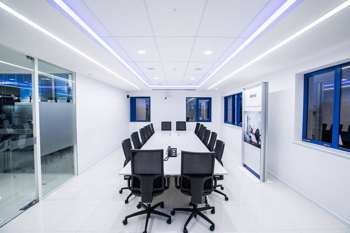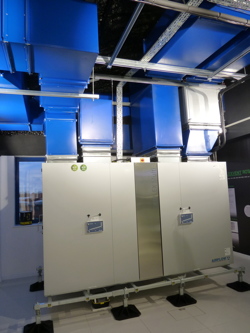Effective ventilation for commercial properties

In a recent report from the Building Engineering Services Association, almost 70% of office workers believed poor air quality was having a negative effect on their wellbeing and productivity. Robert Dennis of Airflow Developments highlights the importance of effective ventilation in commercial buildings to create and maintain a healthy and energy efficient environment.
Commercial buildings are becoming increasingly hermetically sealed. Whilst this will improve energy efficiency by reducing heat loss, it will negatively affect indoor air quality unless adequate ventilation is addressed. Effectively ‘sealing in’ indoor air can expose building occupants to high levels of volatile organic compounds (VOCs), polycyclic aromatic hydrocarbons (PAHs) and microbial pathogens that can lead to asthma, allergies and other respiratory issues — as well as effecting the fabric of the building itself.
With the introduction of the WELL Standard, which primarily focuses on improving human health and wellness through the design and construction of a building, there is a growing emphasis and need to improve indoor air quality. WELL works with key rating systems such as LEED, Green Star and BREEAM to ensure environmental sustainability and requires third-party, onsite testing to ensure projects have achieved key components of the standard.
An effective way to ventilate a commercial property would be through the use of a system that not only extracts stale, unhygienic air but also filters in clean, unpolluted air whilst lowering the environmental impact of a commercial building.
 |
| Airflow’s Air Academy not only provides a best-practice example of indoor air quality and energy efficiency, but also offers a cutting-edge training facility. |
Mechanical ventilation with heat recovery (MVHR) systems do just this by extracting air from inside a building and reclaiming its heat energy via a heat exchanger, which then pre-warms the incoming clean, fresh air that is constantly brought in from outside and circulated within the building. MVHR units recover heat that would normally be lost as part of the ventilation process and, as a result, reduce heat and energy wastage.
When looking for an MVHR system it is important to consider a model that uses high-performance polypropylene exchangers to transfer recovered heat from warm to cold air. Systems are available that can even achieve up to 95% thermal efficiency, which can reduce overall costs by up to 40% as less energy is required to heat incoming air.
The good news is that there are a wide variety of MVHR units available to suit all types of installations. For example, the Airflow Duplexvent Multi eco provides a highly effective ventilation solution, with the capability to ventilate an office with airflows from 500 m3/h (139 l/s) to 7800 m3/h (2167 l/s) at a practically silent 38 dB(A). The system also has a low power consumption, with a specific fan power (SFP) of just 1.27 W/l/s and a high thermal efficiency of over 85%. These highly efficient systems also have a 100% adjustable digital control compatible with the Internet and building-management systems (BMS). The range is highly versatile in its installation options, being available in nine different models with various installation configurations.
Furthermore, Airflow MVHR units can be fitted with G4 and F7 filters that improve the air quality within the building. The G4 filter prevents leaves and pollen from entering the office, effectively protecting those with allergies and hay fever. The F7 filter also removes carbon dioxide and nitrogen dioxide, as well as further harmful pollutants.
 |
| Effective and energy-efficient ventilation for commercial premises — the Duplexvent Multi eco. |
Additionally, MVHR units can also be fitted with a heat pump to reduce energy consumption even further. Heat pumps can serve the dual purpose of heating (with a CoP of around three) and cooling, ensuring a lower initial investment and a simpler operation. When installed with an effective MVHR unit, the heating can be on for a shorter period of time, further reducing the cost and improving the energy efficiency of the building.
With indoor air having the possibility of being up to 50% more polluted then outdoor air, it is vital to install a ventilation system that ensures consistent clean air in an energy-efficient way. Therefore there is more to take into account than simply a good-quality MVHR unit. While this will provide an excellent solution, a filter will offer a belt-and-braces approach to clean air, and a heat pump will guarantee further energy savings to the building.
MVHR units will ensure a healthy supply of indoor air, further enhanced by the use of filters and heat pumps, providing the health attributes needed to ensure the wellness of building occupants and the energy efficiency of the building itself.
Robert Dennis is product marketing executive at Airflow Developments.







